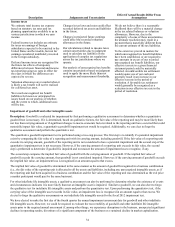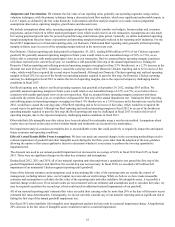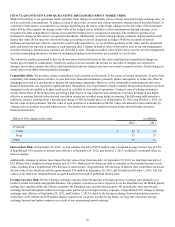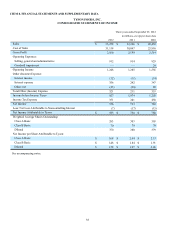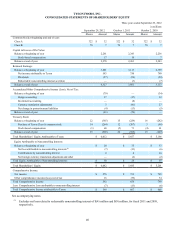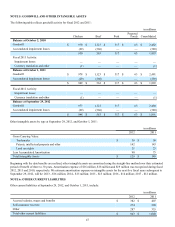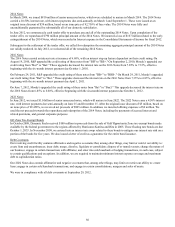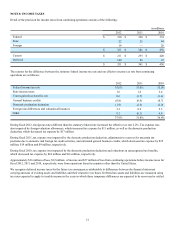Tyson Foods 2012 Annual Report Download - page 42
Download and view the complete annual report
Please find page 42 of the 2012 Tyson Foods annual report below. You can navigate through the pages in the report by either clicking on the pages listed below, or by using the keyword search tool below to find specific information within the annual report.
42
NOTES TO CONSOLIDATED FINANCIAL STATEMENTS
TYSON FOODS, INC.
NOTE 1: BUSINESS AND SUMMARY OF SIGNIFICANT ACCOUNTING POLICIES
Description of Business: Tyson Foods, Inc. (collectively, “Company,” “we,” “us” or “our”), founded in 1935 with world headquarters
in Springdale, Arkansas, is one of the world’s largest meat protein companies and the second-largest food production company in the
Fortune 500. We produce a wide variety of brand name protein-based and prepared food products marketed in the United States and
approximately 130 countries around the world.
Consolidation: The consolidated financial statements include the accounts of all wholly-owned subsidiaries, as well as majority-
owned subsidiaries over which we exercise control and, when applicable, entities for which we have a controlling financial interest or
variable interest entities for which we are the primary beneficiary. All significant intercompany accounts and transactions have been
eliminated in consolidation.
Fiscal Year: We utilize a 52- or 53-week accounting period ending on the Saturday closest to September 30. The Company’s
accounting cycle resulted in a 52-week year for fiscal 2012, 2011 and 2010.
Cash and Cash Equivalents: Cash equivalents consist of investments in short-term, highly liquid securities having original maturities
of three months or less, which are made as part of our cash management activity. The carrying values of these assets approximate their
fair values. We primarily utilize a cash management system with a series of separate accounts consisting of lockbox accounts for
receiving cash, concentration accounts where funds are moved to, and several zero-balance disbursement accounts for funding payroll,
accounts payable, livestock procurement, grower payments, etc. As a result of our cash management system, checks issued, but not
presented to the banks for payment, may result in negative book cash balances. These negative book cash balances are included in
accounts payable and other current liabilities. At September 29, 2012, and October 1, 2011, checks outstanding in excess of related
book cash balances totaled approximately $265 million and $281 million, respectively.
Accounts Receivable: We record accounts receivable at net realizable value. This value includes an appropriate allowance for
estimated uncollectible accounts to reflect any loss anticipated on the accounts receivable balances and charged to the provision for
doubtful accounts. We calculate this allowance based on our history of write-offs, level of past due accounts and relationships with and
economic status of our customers. At September 29, 2012, and October 1, 2011, our allowance for uncollectible accounts was $33
million and $31 million, respectively. We generally do not have collateral for our receivables, but we do periodically evaluate the
credit worthiness of our customers.
Inventories: Processed products, livestock and supplies and other are valued at the lower of cost or market. Cost includes purchased
raw materials, live purchase costs, growout costs (primarily feed, contract grower pay and catch and haul costs), labor and
manufacturing and production overhead, which are related to the purchase and production of inventories.
in millions
2012 2011
Processed products:
Weighted-average method – chicken and prepared foods $ 754 $ 715
First-in, first-out method – beef and pork 611 581
Livestock – first-in, first-out method 952 928
Supplies and other – weighted-average method 492 363
Total inventory $ 2,809 $ 2,587
Property, Plant and Equipment: Property, plant and equipment are stated at cost and depreciated on a straight-line method, using
estimated lives for buildings and leasehold improvements of 10 to 33 years, machinery and equipment of three to 12 years and land
improvements and other of three to 20 years. Major repairs and maintenance costs that significantly extend the useful life of the
related assets are capitalized. Normal repairs and maintenance costs are charged to operations.
We review the carrying value of long-lived assets at each balance sheet date if indication of impairment exists. Recoverability is
assessed using undiscounted cash flows based on historical results and current projections of earnings before interest and taxes. We
measure impairment as the excess of carrying cost over the fair value of an asset. The fair value of an asset is measured using
discounted cash flows including market participant assumptions of future operating results and discount rates.




